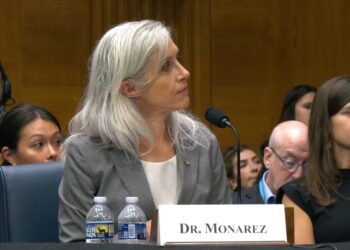### Beyond the Headlines: What the CDC Director’s Firing Teaches Us About AI in Public Health
The testimony of former CDC Director Susan Monarez before the Senate HELP Committee on September 17 was, on its surface, a story of political drama and institutional friction. A leader, hired to navigate a monumental public health crisis, was ultimately dismissed. While commentators will spend weeks dissecting the policy disagreements and personality clashes, I see something else entirely. As a technologist focused on artificial intelligence, I see a high-profile symptom of an analog system cracking under the strain of a digital-age crisis.
The core of the conflict, as is so often the case in these situations, boils down to three fundamental challenges: interpreting vast and noisy data, predicting the consequences of decisions, and maintaining trust. These are precisely the challenges where modern AI and machine learning systems excel. The Monarez firing is a case study in what happens when we rely solely on traditional human analysis in the face of exponential data growth and complexity.
***
#### From Subjective Disagreements to Data-Driven Consensus
Public health crises are, at their heart, massive data problems. We are inundated with information: case counts, hospitalization rates, genomic sequences of new variants, wastewater analysis, mobility data, and supply chain logistics. In the traditional model, teams of human experts collect, clean, and interpret this data to form recommendations. The problem is that when data is this complex and arrives at such a high velocity, human interpretation can become a bottleneck and, worse, a source of subjective disagreement.
One leader might weigh hospitalization rates more heavily, while another focuses on case positivity. This is where high-level conflicts, like the one that led to Monarez’s dismissal, are born.
Now, imagine an AI-driven “decision support dashboard” at the CDC. This system would ingest heterogeneous data streams in real-time, using machine learning models to identify non-obvious correlations that no human team could spot. It could flag a 7-day spike in wastewater viral loads in a specific county that correlates with mobility data from a recent event, predicting a surge in hospitalizations 10-14 days before it appears in clinical settings. The debate then shifts from “I believe we should focus here” to “The model, with 92% accuracy based on back-testing, shows this region is the highest priority.” It doesn’t eliminate human judgment, but it grounds the conversation in a common, data-driven reality.
#### The Power of Predictive Simulation
A key responsibility of the CDC is to provide guidance on interventions, from mask mandates to travel restrictions. These decisions are fraught with political and economic consequences. The testimony hinted that disagreements over the potential impact of such guidance were a major point of friction.
This is where predictive simulation, a powerful application of AI, becomes transformative. Instead of debating the theoretical effects of a policy, we can model them. Using agent-based modeling, we can create a “digital twin” of a community or even a whole state. This simulation accounts for demographics, traffic patterns, social behavior, and viral transmission dynamics.
With such a tool, a director like Monarez could have presented policymakers with clear, modeled outcomes:
* **Scenario A (Current Policy):** Projects a 30% increase in hospital admissions over 4 weeks.
* **Scenario B (Targeted Masking Guidance):** Flattens the curve, projecting only a 5% increase.
* **Scenario C (Full Lockdown):** Reduces admissions by 10% but shows a severe negative impact on modeled economic indicators.
This transforms the discussion from a political argument into a quantitative risk/reward analysis. It provides leaders with robust, defensible evidence for their recommendations, making it much harder to dismiss that advice based on political winds alone.
#### Rebuilding Trust with Explainable AI
Ultimately, the breakdown between a public health leader and the government they serve is an issue of trust. This trust deficit extends to the public, who are often asked to follow guidance without a clear understanding of the underlying rationale.
This is where the field of Explainable AI (XAI) is critical. Early AI models were often “black boxes”—they gave you an answer but couldn’t tell you how they reached it. Modern XAI techniques are designed for transparency. An XAI-powered public health system wouldn’t just say, “Recommend closing indoor dining.” It would provide the “why”:
* *Because contact tracing data from the last 21 days shows indoor dining as the source of 38% of new transmission clusters.*
* *Because our mobility simulation shows a 70% reduction in high-risk contacts if this single measure is implemented.*
This transparency serves two purposes. It empowers leaders to justify their decisions with clear, auditable data, and it helps build public trust by showing the logic behind difficult and disruptive public health measures.
***
#### Conclusion: Augmenting, Not Replacing, Leadership
The dismissal of Susan Monarez is a reminder that even the most capable leaders can be stymied by broken systems. Her expertise was not the problem; the problem was an institutional framework ill-equipped for the speed and scale of a modern crisis.
AI is not a panacea. It won’t eliminate tough decisions or political pressure. But by providing a common ground of data-driven reality, offering powerful tools for predictive forecasting, and enabling transparent communication, it can fundamentally change the nature of the conversation. The goal is not to replace experts like Dr. Monarez with an algorithm, but to augment their expertise, arming them with the tools to make faster, better, and more defensible decisions when it matters most. Investing in this technological infrastructure for our public health institutions is not a luxury; it is an absolute necessity for surviving the next crisis.
This post is based on the original article at https://www.bioworld.com/articles/724187-monarez-gives-her-side-of-how-she-was-fired-from-the-cdc.


















